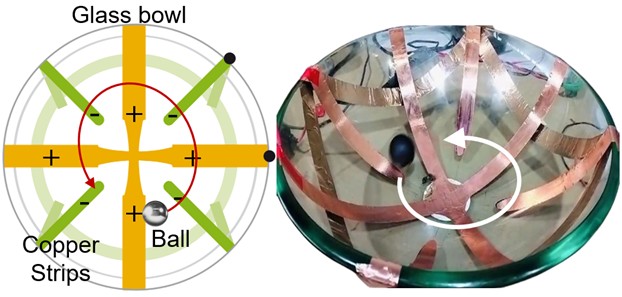Electrostatic Accelerator
Electrostatic Accelerator
What is this exhibit? This exhibit shows the working principle of an electrostatic particle accelerator
What is that you see? There is a glass bowl which has alternate copper strips connected to + and - of a high voltage DC power supply. When switched on, we can see that the ping-pong ball (coated with conducting paint) starts moving and slowly gains speed and then keeps rotating inside the glass bowl. When power is increased, the ball moves faster and higher up in the glass bowl.
What is the principle? High voltage DC (~10,000V) is applied to the metal strips in the bowl (alternate strips are connected to either + or -) which means that these metal strips are charged (either positively or negatively). The moment the ball comes into contact with one of the charged strips, it picks up that charge. Because both the ball and the strip now have the same charge, they repel each other: the ball moves away. It then rolls onto an earthed strip, causing the ball to neutralize and lose its charge. This cycle continues. The ball is accelerated every time it touches a charged strip and decelerates in between strips due to the friction with the bowl. Without the conductive coating on the ball, the ball could neither charge nor discharge, so it would not accelerate.
Applications: High energy particle accelerators are used for various applications including exploring fundamental science (Large Hadron Collider) and for medical applications such as radiotherapy, proton and neutron radiotherapy as well as for production of positron emitting radionuclides for Positron Emission Tomography (PET) scans.
|
 The model of electrostatic accelerator
|
© IPR, 2017-18
Home Academic Visits | IPR Outreach | Comic Book | Exhibition Hall | Plasma Exhibition | People | Resource Materials | NSD-2025 | Social Outreach | Solar Telescope | Training Program | TokoToy | Vigyan Samagam | 2022 Events | 2023 Events | 2024 Events | 2025 Events | Upcoming Events | FAQ FAQ | Contact Contact | Ask A Question Ask A Question | Talk 2 Us Interact with a Plasma Scientist |
